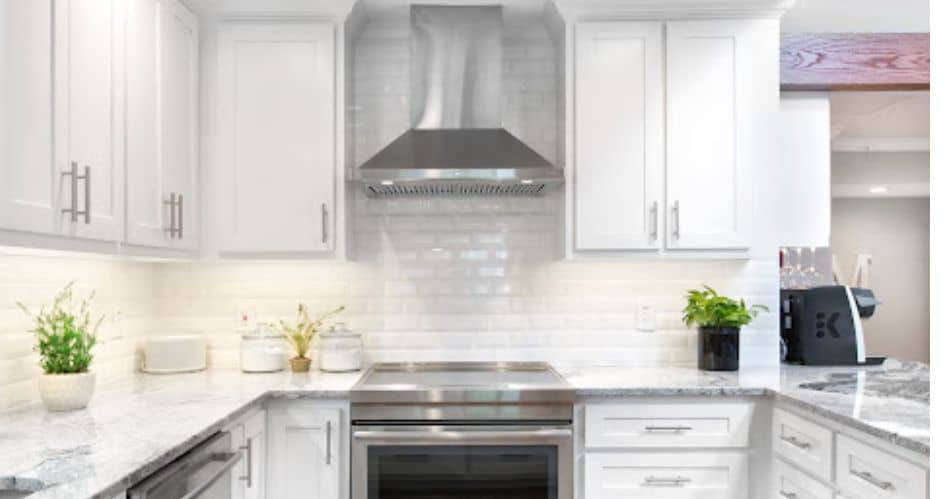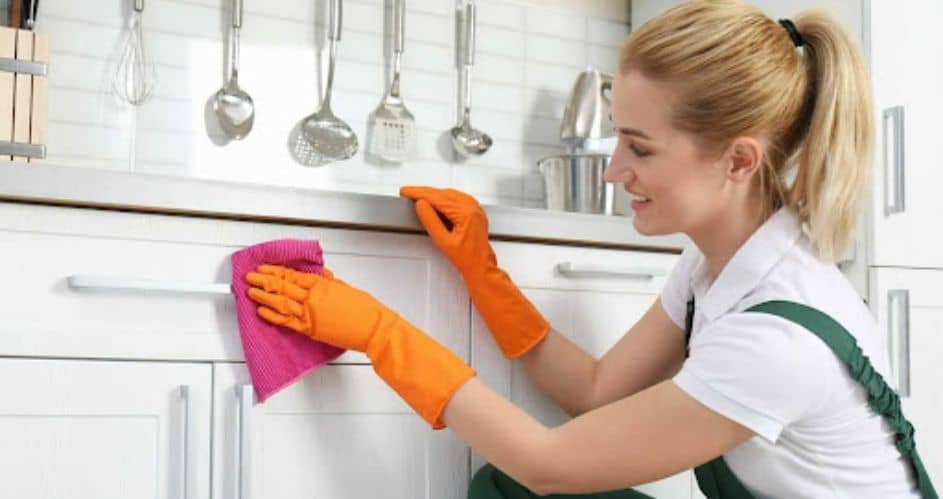
Keeping your kitchen cabinets clean can be challenging as it’s inevitable for dust, grease, and food particles to accumulate over time. Neglecting your cabinets can result in bacterial growth and mold, potentially putting your loved ones at home at risk of diseases and illnesses.
It can be challenging to maintain white cabinets as they can quickly reveal the slightest amount of dirt or grime, making your kitchen look unkempt even when the rest of it is clean.
White cabinets also tend to turn yellow over time, especially when exposed to direct sunlight or smoke from cooking, detracting from their pristine appearance.
To avoid this, here are some detailed hacks that kitchen cabinet specialists would typically advise homeowners to do:
Determine What Your Cabinet’s Material Before Cleaning
Whether your cabinets are crafted from wood, laminate, glass, or metal, it’s essential to understand how these different materials react to various cleaning agents.
Non-abrasive cleaners are ideal for wood cabinets to avoid damaging their delicate surface. On the other hand, laminate cabinets are a bit more resilient to cleaning solutions but still require care as they are prone to warping or peeling.
Glass cabinet doors, while visually appealing, are challenging to keep clean as they require constant wipe-downs with a gentle glass cleaner to keep fingerprint smudges and grease marks at bay. Metal cabinets, though sturdy, can be susceptible to scratches and corrosion if not correctly cared for.
How To Keep White Cabinets Clean
There are multiple ways to clean white cabinets and maintain their pristine condition. Remember that white cabinets are more prone to showing stains, smudges, and the accumulation of dirt and grease, which can be particularly noticeable compared to darker surfaces.
Here are some ways you can keep your white cabinets as clean as possible:
Daily Cleaning
Wipe Down Surfaces:
Use a soft microfiber cloth to wipe down cabinet surfaces every day gently. This prevents dust and grime buildup and maintains the cabinets’ bright appearance.
Cleaning Up Spills Immediately:
It can be tempting to ignore and set aside spills and splatters, but white cabinets tend to stain a lot more easily than darker-colored ones. The sooner you wipe up liquids and foods, the less likely they will stain or damage the cabinet surface.
Mild Cleaning Solutions:
A mixture of water and mild dish soap is gentle yet effective for everyday cleaning. It can remove most surface dirt and food residues without harming the paint or finish.
Deep Cleaning Your Cabinets

Daily cleaning is not enough to maintain your white cabinets. Setting aside at least one day every month for a thorough deep cleaning is also important. Here’s a helpful step-by-step guide on how to deep cleaning your kitchen cabinets:
Prepare Your Cleaning Solution:
The most common cleaning solution homeowners use to clean white cabinets is a mix of mild dishwashing soap with two parts of hot water. You can also mix equal parts distilled white vinegar and hot water. Warm water helps to soften grease, making it easier to remove.
Remove All Items from Your Cabinets:
Before cleaning your kitchen cabinets, make sure to empty them. Without clutter, you can spot dirt, grease buildup, and areas needing repair or touch-ups.
Dust and Vacuum:
It’s inevitable that you will find crumbs and particles in your cabinets, which is why you should not skip dusting and vacuuming them. Use a soft brush attachment on your vacuum to remove dust and crumbs from inside the cabinets.
Clean the Exterior:
Spray your cleaning solution onto a microfiber cloth and gently wipe the outside of the cabinets. For painted wood, vinegar and water solution is gentle yet effective.
Tackling Tough Stains:
For stubborn stains on wood cabinets, a paste made from baking soda and water can be applied; let sit for a few minutes, then wipe clean with a damp cloth.
Cleaning Hardware and Crevices:
Use an old toothbrush dipped in your cleaning solution to scrub hard-to-reach areas around handles and decorative elements.
Dry Thoroughly:
After cleaning, use a dry microfiber cloth to dry all surfaces. Ensuring wood doesn’t stay wet is crucial to prevent damage.
How To Clean White Cabinets That Have Yellowed
Several factors can cause your white cabinets to turn yellow. Exposure to direct sunlight is one of the main reasons. This is because the harsh UV rays from the sun can break down the chemical bonds in paint and finishes, leading to discoloration over time.
Similarly, smoke from cooking, candles, or tobacco can leave a residue on surfaces that gradually yellows. The age of the cabinets also plays a role, as older paint formulations were more prone to yellowing, especially if they were oil-based. Here are some tips on how to clean white cabinets that have yellowed:
Use a 50/50 White Vinegar and Water Solution
Did you know that a mixture of white vinegar and water in equal parts, stored in a spray bottle, can serve as a gentle yet powerful cleaning solution that tackles grease without damaging finishes? Spray the solution onto the cabinet’s surface or spray it on a microfiber cloth and use it to wipe the surface.
Take Advantage of the Power of Baking Soda
Baking soda is also another powerful cleaning agent that can be found in your home. It can lift even the most stubborn stains from your white cabinets. Combine baking soda with enough water to create a thick paste, then apply it to the stained areas.
Let it sit briefly before gently scrubbing it with a soft brush or cloth. This method allows the baking soda to penetrate the stain deeply before gently scrubbing removes it, leaving your cabinets looking refreshed and bright.
Adding Mild Detergent or Dish Soap to Your Vinegar Solution
Mix a few drops of your favorite mild dish soap into the vinegar and water solution for an extra kick against kitchen grease and grime. This blend enhances the grease-fighting power of the mixture, making it even more effective against stubborn kitchen grime.
Apply this upgraded solution with a soft microfiber cloth, gently wiping the cabinets to dissolve and remove grease without harming the surface. This simple addition can significantly affect your cleaning regimen, ensuring a deeper clean with minimal effort.
Conclusion
Whether you are planning on updating your kitchen or you want to maintain your current kitchen interior, cleaning your white kitchen cabinets will always be an essential task. Without proper care, your white kitchen cabinets can quickly look neglected and dirty.
Incorporating cabinet cleaning into your routine ensures that your kitchen retains its charm and remains a focal point of your home.
